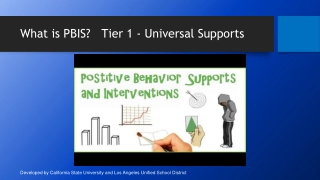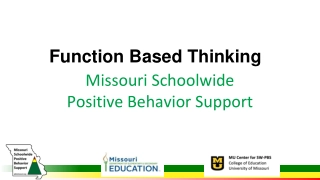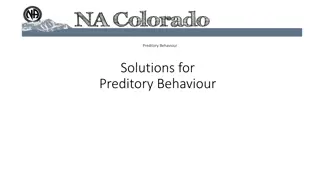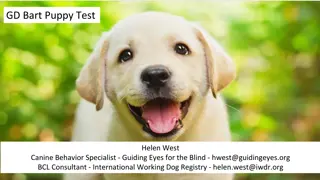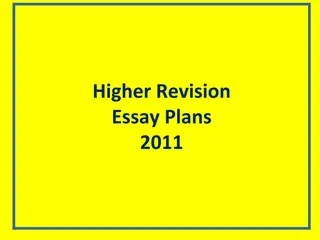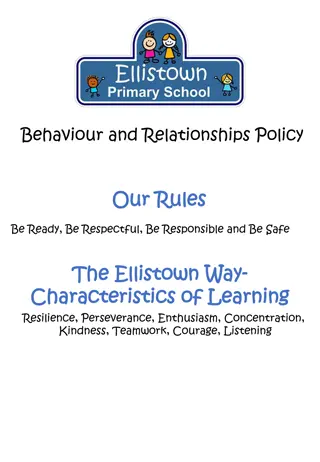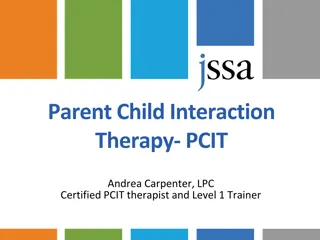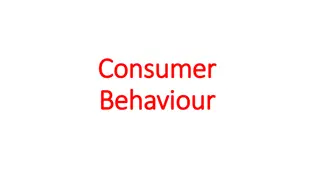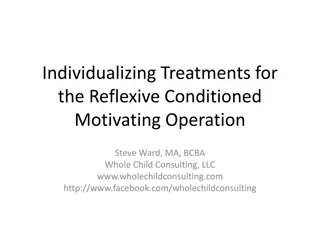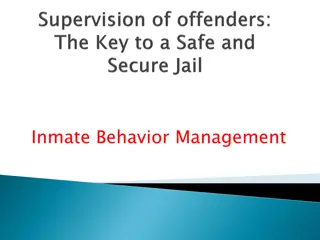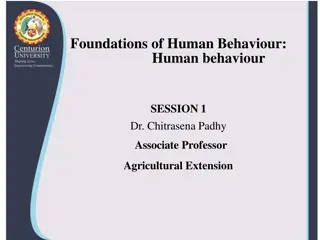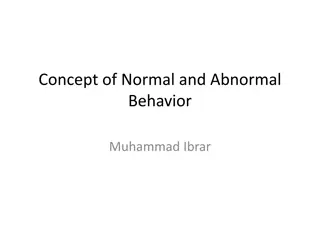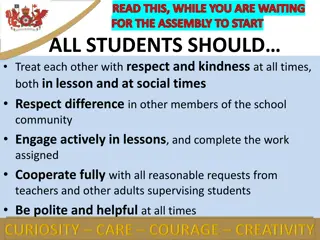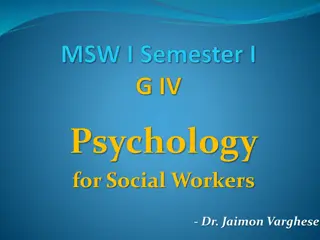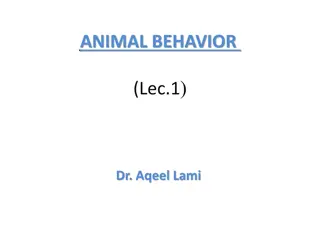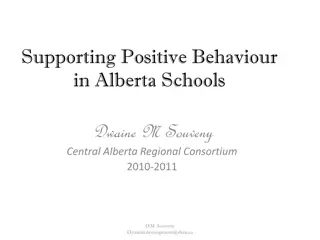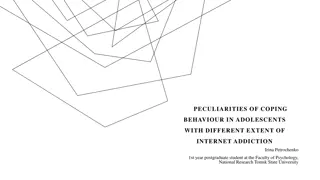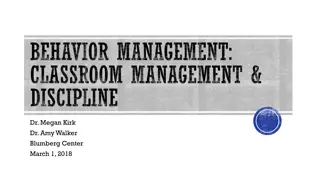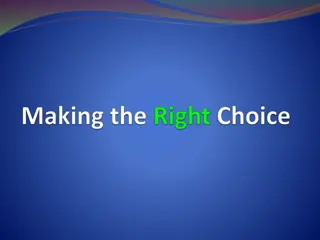
Positive Behavior Support Strategies for Children
Explore the process of Positive Behavior Support including establishing goals, gathering information, developing hypotheses, designing behavior support plans, and implementing strategies. Learn about understanding challenging behaviors, developing new skills, and implementing interventions effectively.
Download Presentation

Please find below an Image/Link to download the presentation.
The content on the website is provided AS IS for your information and personal use only. It may not be sold, licensed, or shared on other websites without obtaining consent from the author. If you encounter any issues during the download, it is possible that the publisher has removed the file from their server.
You are allowed to download the files provided on this website for personal or commercial use, subject to the condition that they are used lawfully. All files are the property of their respective owners.
The content on the website is provided AS IS for your information and personal use only. It may not be sold, licensed, or shared on other websites without obtaining consent from the author.
E N D
Presentation Transcript
+ Kara Bratton Resource Center Director Lutheran Special Education Ministries kbratton@luthsped.org; 260-385-4033 Behavior Interventions and Strategies https://luthsped.org/2017/10/18/be havior-interventions/
+Positive Behavior Support If a child doesn t know how to read, we teach. If a child doesn t know how to swim, we teach. If a child doesn t know how to multiply, we teach. If a child doesn t know how to drive, we teach. If a child doesn t know how to behave, we........... ..........teach? .........punish? Why can t we finish the last sentence as automatically as we do the others? Tom Herner (NASDE President ) Counterpoint 1998, p.2
+Process of Positive Behavior Support Step 1: Establishing a collaborative team and identifying goals Step 2: Gathering information (functional assessment) Step 3: Developing hypotheses Step 4: Designing behavior support plans Step 5: Implementing, monitoring, and refining behavior support plan
+Process of Positive Behavior Support Behavior Hypotheses/Function of Behavior - Purpose of the behavior, your best guess about why the behavior occurs Prevention Strategies -Ways to make events and interactions that trigger challenging behavior easier for the child to manage Replacement Skills New skills to teach throughout the day to replace the challenging behavior Responses -What adults will do when the challenging behavior occurs to ensure that the challenging behavior is not maintained and the new skill is learned
+ Changing Our View of Challenging Behavior Understand why challenging behaviors happen and what purpose they serve Focus on developing a broader range of skills and outcomes for children Implement interventions for these behaviors at an early age that help children learn new behaviors Develop preventative interventions that are practical and ongoing
+Changing Our View of Challenging Behavior Take the problem away from the child and ask: Why is this behavior occurring? What changes can I make to prevent the problem from occurring and teach the child new skills? (http://challengingbehavior.fmhi.usf.edu/explore/presentation_docs/9.04_addressing_challenging.pdf)
+Functional Behavioral Assessments Behavior is a means of communication; undesirable behavior satisfies some kind of need for the student Behavior leads to response Every behavior is an attempt to obtain a response and gain something This is determining the reason and function of the undesirable behavior Behavior will not change unless the student s need (function of behavior) is determined and more appropriate way to meet that need is found
+Functional Behavioral Assessments ABC s of FBAs Antecedent: factors in the environment present before the behavior occurs Physical environment, instructional factors, subject, activity, size of group, who is/is not present, noise, location, time of day Anything specific to that student such as level of fatigue, hunger, etc. Behavior: what the student does, and/or does not do Consequence: what happens after the behavior Includes actions of teachers, peers, things the student avoids or obtains, changes in the environment
+Functions of Behavior Escape Desire to get away from a person, activity, or setting Example: Student runs out of the classroom Attention Desire for attention from others; may or may not be a specific person or group Example: Student making jokes while teacher is talking Sensory Desire to obtain or get away from a particular sensory experience Example: Student has trouble in the crowded lunchroom Tactile Desire for a specific item Example: Student pushes or hits to get a particular classroom item
+Replacement Behaviors Replacement behaviors meet the same need/have the same function as undesirable behavior Meet the need/function in a more appropriate way Intervention should increase the use of the replacement behavior Consider whether the student needs to be taught how to perform the replacement behavior, or whether the student knows how to perform the desired behavior
+Behavior Interventions Effective interventions shift the payoff so that it occurs for positive behaviors, and no payoff happens for negative behaviors Achieved through teaching replacement behaviors Behavior Intervention Plans typically fail either because the function has not been properly identified or the plan was not implemented completely and consistently Expect a decrease in frequency of behavior, but then a slight increase Over time, undesirable behavior will decrease and positive behavior will increase but it does not happen overnight
+Behavior Interventions Behavioral Analysis Worksheet (handout) or Functional Behavioral Assessment (handout) Once Function of Behavior is established, refer to Strategies and Replacement Behaviors (handouts) listed under the appropriate function Handouts have samples of undesirable behaviors linked to appropriate replacement behaviors based on function Record on sample Behavior Intervention Plan forms
+Behavior Strategies- Proactive Interventions To develop an intervention ask yourself... What can I do to change the behavior? How can I modify or change the factors that contribute to the behavior? What can I teach the child to use as a replacement behavior that addresses the same purpose or outcome? How will I teach the replacement behavior to the child? How can I make sure that I am NOT reinforcing the outcome of the challenging behavior? How can I reinforce the replacement behavior so that it matches the function of the challenging behavior?
+ Practice Behavior Possible Function Escape lunch room Gain attention Escape gym class (motor activities) Gain access to desirable item Get help from parent Gain sensory stimulation Escape activity Avoid peer interaction Gain attention from adults Escape demands (academic) Yelling Hitting Swearing
+ Example 1 Jared talks out at least two times per class. He smiles, and other students snicker, when his teacher reminds him to raise his hand. Since the beginning of the year, the problem seems worse. Do the reminders reinforce or punish him? How do you know? What might be the function of this behavior?
+ Example 2 Colleen has an argument with someone in the cafeteria at least 3 times per week. The consequence is to stay in at recess and read or work on the computer with the teacher. Is the consequence serving as a reward or punisher? What might the function of Colleen s behavior be?
+ Scenario #1 Tisha, a three year old with ASD, is building a block structure during work time. Her teacher tells the group that work time will be ending in 5 minutes. Tisha is not finished with her structure. When work time is over the teacher reminds the kids to clean up their work and put their materials away. Tisha starts kicking and screaming, hitting anyone who is near her. She hits the teacher who comes to tell her it is time to clean up. The teacher takes the blocks and puts them in the container, leaving a few for Tisha to put away. Tisha continues to kick and scream. This happens each time Tisha is reminded to clean up her work.
Antecedent Conse- quences Behavior Reinforce- ment or Punish- ment Function of Behavior Replace- ment Behaviors
+ Scenario #2 Bob, a young man with Asperger Syndrome, yells out This is stupid when given an assignment in his inclusive social studies class. His teacher calls his name sternly and tells him that he has a WARNING. After a few minutes, Bob yells again I don t want to do this pathetic work . The teacher yells at Bob and gives him STRIKE 1. After a few more minutes, Bob yells, Only a moron would want to write about the Aztecs . The teacher yells again, saying he is sick of Bob s comments, Bob has a bad attitude, Bob has no consideration for his classmates, etc. and gives Bob STRIKE 2. Each time Bob comments, the teacher yells and gives him a strike. Bob behaves this way at least one time per day.
Antecedent Conse- quences Behavior Reinforce- ment or Punish- ment Function of Behavior Replace- ment Behaviors
+ Scenario #3 Whenever Susie is given written tests, she both scribbles her name on the test and pushes it aside or she crumbles the test into a ball and throws it away. Her teacher tells her that she will receive a zero on the test, that she is failing the class, that she should have at least made an effort. The teacher also required that Susie spend the rest of the class time sitting quietly at her desk and not disturbing others.
Antecedent Conse- quences Behavior Reinforce- ment or Punish- ment Function of Behavior Replace- ment Behaviors
+Your classroom scenario Think of a student in your classroom with undesirable behavior Complete as much of the ABC chart as you can to determine the function of the behavior After you have determined the function, identify some potential interventions and replacement behaviors that may be effective at decreasing the undesired behavior
Antecedent Conse- quences Behavior Reinforce- ment or Punish- ment Function of Behavior Replace- ment Behaviors
+Resources Ventura County RtI2 Behavior Interventions Guide http://www.vcoe.org/rti2-mtss/forms (individual forms) http://www.vcoe.org/Portals/7/Curriculum- Instruction/Documents/RtI/RtIHandbook5-7-14.pdf (entire handbook)

